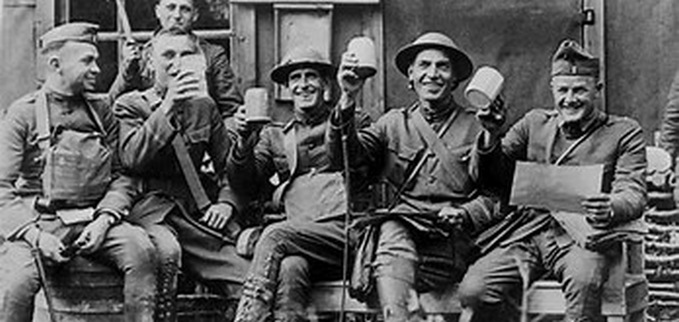 I'm Right Again Dot Com
I'm Right Again Dot Com
An Online Publication of the Anonymous Anything Society — November 12, 2018
WORLD WAR I: July 28, 1914 - November 11, 1918
This remembrance has been in the making for 85 years. I was six years old in 1933 on Armistice Day. I was standing a few feet from a monument dedicated to the memory of the men of Carterville, Illinois (1930 population, 2,866) who gave their lives in "The War To End All Wars." A small band of veteran survivors are still marching-by in my memory, in their ill-fitting, woolen uniforms. Most had probably taken on weight since they had fought in the battles of Argonne, Belleau Wood, Chatteau-Tierry, Marne and Saint Mihiel, France.
What I recollect most vividly were the puttees that each had patiently wound around their legs above their government issue (G.I.) shoe tops. Only a few had preserved their small "tin-pot" helmets, although all had one or more medals pinned to the left side of their chests; medals I learned many years later from reading Barbara Tuchman's comprehensive history of WWI: "The Guns of August," were earned in ferocious combat, shelling and gas attacks in the disputed trenches crossing Belgium, and Northeast France. At one point in the conflict, Big Bertha, a gigantic German artillery piece mounted on a railroad car, was nearly capable of firing on Paris.
More than eight million people died in WW I. It all began in June of 1914 with the assassination by a Serbian terrorist of Archduke Ferdinand and Archduchess Sofia of Austria-Hungary. Serbia was then a contested part of Austria-Hungary, but its move towards independence was supported by Tsarist Russia. Germany joined Austria in the ensuing conflict. France, Great Britain, Italy and finally. the USA, while responding to a German submarine attack on The Lusitania ocean liner that took 1,198 lives, also joined what became the victorious Allied forces.
In the weeks prior to November, 1918, great masses of German soldiers and sailors were becoming communists, in concert with the revolutionaries of Bolshevik Russia. The red flag was being raised over hundreds of soviets (self governed gatherings) everywhere in Deutschland. German soldiers and sailors were deserting in droves.
Germany sued for peace on November 7th, 1918. French Marshall Ferdinand Foch, the commander-In-Chief of Allied Forces, imposed stringent demands: The immediate withdrawal of German forces from France, Belgium and two provinces, Alsace and Lorraine, that had been ceded to Germany by France after a earlier conflict, along with the east bank of the German Industrial Rhineland and vast amounts of military hardware, vehicles, aircraft and railway rolling stock.
In the meantime, the German military commander, Erich Ludendorff, had a nervous breakdown and Kaiser Wilhelm II fled to neutral Holland. After four days, during which Foch continued to urge that Allied forces "hasten and intensify their efforts," the junior grade German officers, sent as negotiators to the railroad forest clearing of Compiegne, France by the German High Command, capitulated and signed the "Armistice" document.
In the five weeks between when the German peace envoys appeared on the German western front and November 11th, a half-million more men in the two sides died in combat; some within minutes of an agreed upon 11:00 a.m. cease fire that day.
The World War I "doughboys" of my childhood were preceded by the High School marching band. They were followed by one vehicle carrying the owner-driver and four graying veterans of the Spanish-American war. A second car carried one person: the last, living Civil War veteran in my hometown; a man who served as a drummer boy for General John A. Logan, a division commander under Ulysses S. Grant. The name of the Union Army veteran escapes me, but I remember he had been the town blacksmith for many years; a cranky old "scutter," who spent most of each day of his later years in his front porch swing. He would not suffer roller skating on the sidewalk in front of his home.
On that 1933 Armistice day, a monument had been erected in the center of the intersection of Carterville's two most important streets: North Division Street and Illinois Avenue, constituting the "downtown" or business district of Carterville. A genuine, water-cooled .50 caliber machine gun was installed at the top and a metal plate was affixed to the monument, inscribed with the names of a dozen or more fallen service members from the community.
As directed by the drum major, the band split into two echelons when approaching the monument and reformed on the other side, as did the veteran "doughboys" on foot. The lead vehicle chose one side, rounding the monument clockwise. The driver of the following car took a counter-clockwise route around the monument. The parade proceeded south on Division Street for some three miles and turned west on Elles Avenue, then some blocks to the entrance to Hillcrest cemetery, where my father, mother and numerous members of our prolific Scottish clan rest.
The day of the parade, Frank Ledbetter, owner and editor of The weekly Carterville Herald newspaper, had published a rousing, patriotic editorial dedicated to the men of Carterville who had given their lives in the "Great War." After services at the well-groomed, flag bedecked cemetery that included an address by Illinois Governor-elect Henry Horner, Ledbetter returned to the Herald, transcribed some notes he had made during the celebration, got in his car, headed toward his home on South Division street and drove straight into the monument, located a half block south of his newspaper's office. Ledbetter was pronounced slightly injured and sober, but deeply humiliated. The monument was, for all practical purposes, destroyed. As far as I know, it was never replaced.
-Phil Richardson, Observer of the Human Condition and Storyteller
"He goes doddering on into his old age, making a public nuisance of himself."—Joseph Menchen
Our unending thanks to Jim Bromley, who programs our Archive of Prior Commentaries
Respond to: k7os@comcast.net